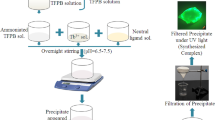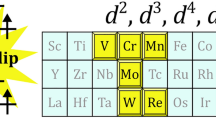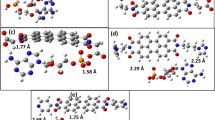Abstract
In this work, the geometrical, optical, and phosphorescence properties of four complexes with general formula [dRpypy—C(OCH3)R′—dRpypy]Pt, with Pt-1 (R = F, R′ = methyl), Pt-2 (R = F, R′ = hexyl), Pt-3 (R = methoxy, R′ = methyl) and Pt-4 (R = methoxy, R′ = hexyl), were studied using the B3PW91 and TD-B3PW91 methods. The effect of the double substitution R and R′ on the electronic properties of the four complexes has been investigated. Replacing the two fluorine atoms with the two methoxy groups modifies the shape of the UV–vis spectra and red shift the phosphorescence spectra, while the substituents on the linker R′ do not induce changes in both absorption and phosphorescence spectra. Normal modes involved in the vibronic structure were identified and analyzed using adiabatic Hessian approaches according to the Franck–Condon approximation. The computed phosphorescence wavelengths agree with the observed ones and indicate that the fluorinated complexes exhibit a bright light blue color, while the methoxy complexes display a light spring green color. Further, temperature effects on simulated phosphorescence spectra were studied.





Similar content being viewed by others
References
Yu T, Zhang C, Zhao Y, Guo S, Liu P, Li W, Fan D (2013) Synthesis, crystal structure and photoluminescence of a cyclometalated iridium(III) coumarin complex. J Fluoresc 23(4):777–783. https://doi.org/10.1007/s10895-013-1214-x
Latouche C, Skouteris D, Palazzetti F, Barone V (2015) TD-DFT benchmark on inorganic Pt(II) and Ir(III) complexes. J Chem Theory Comput 11(7):3281–3289. https://doi.org/10.1021/acs.jctc.5b00257
Schira R, Latouche C (2021) DFT vs. TDDFT vs. TDA to simulate phosphorescence spectra of Pt- and Ir-based complexes. Dalton Trans 50(2):746–753. https://doi.org/10.1039/d0dt03614e
Mezouar H, Brahim H (2022) Theoretical investigation on orange-emitting cyclometalated platinum (II) complexes containing organosilyl/organocarbon-substituted 2-(2-thienyl)pyridine ligands. Photochem Photobiol Sci. https://doi.org/10.1007/s43630-022-00192-5
Seghir I, Nebbache N, Brahim H (2021) Geometric, optical, and phosphorescent properties of cationic Ir(III) and Rh(III) complexes with cyclometalated ligands: DFT/TDDFT investigations. Monatshefte für Chemie - Chem Mon 152(3):315–322. https://doi.org/10.1007/s00706-021-02750-6
Brahim H, Haddad B, Boukabene M, Brahim S, Ariche B (2017) Theoretical study of geometric structures and electronic absorption spectra of Iridium(III) complexes based on 2-phenyl-5-nitropyridyl with different ancillary ligands. Comput Theor Chem 1101:8–19. https://doi.org/10.1016/j.comptc.2016.12.016
Brahim H, Daniel C, Rahmouni A (2011) Spin-orbit absorption spectroscopy of transition metal hydrides: a TD-DFT and MS-CASPT2 study of HM(CO)5 (M = Mn, Re). Int J Quantum Chem 112(9):2085–2097. https://doi.org/10.1002/qua.23219
Leesakul N, Kullawanichaiyanan K, Mutić S, Guzsvány V, Nhukeaw T, Ratanaphan A, Saithong S, Konno T, Sirimahachai U, Promarak V (2021) A photoactive iridium (III) complex with 3-methyl-2-phenyl pyridine and 1, 1-bis (diphenylphosphino) methane: synthesis, structural characterization and cytotoxicity in breast cancer cells. J Coord Chem 74(14):2380–2394
Chen S, Gai X, Liang J, Ye K, Liu Y, Wang Y (2021) Highly efficient phosphorescent organic light-emitting diodes based on novel bipolar iridium complexes with easily-tuned emission colors by adjusting fluorine substitution on phenylpyridine ligands. J Mater Chem C 9(26):8329–8336. https://doi.org/10.1039/d1tc01498f
Liu X, Wu S, Wang Y, Li Y, Wang R, Yu T, Su W, Zhao Y, Zhang D (2021) Synthesis and luminescence properties of two cross-linkable Ir (III) complexes. New J Chem 45(40):19154–19163
Naoui M, Brahim H, Guendouzi A (2020) Theoretical investigation on green emitting heteroleptic cyclometalated iridium(III) complexes with fluorinated 2-phenylpyridine ligands. J Photochem Photobiol, A 398:112624. https://doi.org/10.1016/j.jphotochem.2020.112624
Brahim H, Haddad B, Brahim S, Guendouzi A (2017) DFT/TDDFT computational study of the structural, electronic and optical properties of rhodium (III) and iridium (III) complexes based on tris-picolinate bidentate ligands. J Mol Model. https://doi.org/10.1007/s00894-017-3517-3
Brahim H, Daniel C (2014) Structural and spectroscopic properties of Ir(III) complexes with phenylpyridine ligands: absorption spectra without and with spin–orbit-coupling. Comput Theor Chem 1040–1041:219–229. https://doi.org/10.1016/j.comptc.2014.01.030
Stoliaroff A, Rio J, Latouche C (2019) Accurate computations to simulate the phosphorescence spectra of large transition complexes: simulated colors match experiment. New J Chem 43(30):11903–11911. https://doi.org/10.1039/c9nj02388g
Brahim H (2019) DFT/TD-DFT investigation on the UV–vis absorption and phosphorescence spectra of platinum(II) and palladium(II) complexes with Schiff-base ligands. J Lumin 210:96–103. https://doi.org/10.1016/j.jlumin.2019.02.030
Puttock EV, Sturala J, Kistemaker JC, Williams JG (2021) Platinum (II) complexes of tridentate-coordinating ligands based on imides, amides, and hydrazides: synthesis and luminescence properties. Eur J Inorg Chem 2021(4):335–347
Boukabene M, Brahim H, Hadji D, Guendouzi A (2020) Theoretical study of geometric, optical, nonlinear optical, UV–Vis spectra and phosphorescence properties of iridium(III) complexes based on 5-nitro-2-(2′,4′-difluorophenyl)pyridyl. Theor Chem Acc. https://doi.org/10.1007/s00214-020-2560-9
Hruzd M, Le Poul N, Cordier M, Kahlal S, Saillard J-Y, Achelle S, Gauthier S, Robin-Le Guen F (2022) Luminescent cyclometalated alkynylplatinum (ii) complexes with 1, 3-di (pyrimidin-2-yl) benzene ligands: synthesis, electrochemistry, photophysics and computational studies. Dalton Trans 51(14):5546–5560
Li X, Hu J, Wu Y, Li R, Xiao D, Zeng W, Zhang D, Xiang Y, Jin W (2017) Tunable luminescence of cyclometallated platinum (II) derivatives based on novel pyrimidine-contained tridentate Pt (NˆCˆN) Cl complexes. Dyes Pigm 141:188–194
Hadji D, Brahim H (2018) Structural, optical and nonlinear optical properties and TD-DFT analysis of heteroleptic bis-cyclometalated iridium(III) complex containing 2-phenylpyridine and picolinate ligands. Theor Chem Acc. https://doi.org/10.1007/s00214-018-2396-8
Huh JS, Sung MJ, Kwon SK, Kim YH, Kim JJ (2021) Highly efficient deep blue phosphorescent OLEDs based on tetradentate Pt (II) complexes containing adamantyl spacer groups. Adv Funct Mater 31(23):2100967
Zhang H, Wang W, Liu C, Peng Z, Du C, Zhang B (2021) Highly phosphorescent platinum (ii) complexes supported by (2-(1 H-benzimidazole)-phenyl) diphosphine oxide ancillary ligands. J Mater Chem C 9(30):9627–9636
Cebrián C, Mauro M (2018) Recent advances in phosphorescent platinum complexes for organic light-emitting diodes. Beilstein J Org Chem 14(1):1459–1481
Li G, Liu S, Sun Y, Lou W, Yang Y-F, She Y (2022) N-Heterocyclic carbene-based tetradentate platinum (ii) complexes for phosphorescent OLEDs with high brightness. J Mater Chem C 10(1):210–218
Li G, She Y (2018) Tetradentate cyclometalated platinum(II) complexes for efficient and stable organic light-emitting diodes. In: Light-emitting diode - an outlook on the empirical features and its recent technological advancements, InTech. https://doi.org/10.5772/intechopen.76346
Wu C, Zhang Y, Miao J, Li K, Zhu W, Yang C (2023) Tetradentate cyclometalated platinum complex enables high-performance near-infrared electroluminescence with excellent device stability. Chin Chem Lett 34(2):107445
Guelai A, Brahim H, Guendouzi A, Boumediene M, Brahim S (2018) Structure, electronic properties, and NBO and TD-DFT analyses of nickel(II), zinc(II), and palladium(II) complexes based on Schiff-base ligands. J Mol Model. https://doi.org/10.1007/s00894-018-3839-9
Lee C, Zaen R, Park K-M, Lee KH, Lee JY, Kang Y (2018) Blue phosphorescent platinum complexes based on tetradentate bipyridine ligands and their application to organic light-emitting diodes (OLEDs). Organometallics 37(24):4639–4647
Perdew JP (1986) Density-functional approximation for the correlation energy of the inhomogeneous electron gas. Phys Rev B 33(12):8822–8824. https://doi.org/10.1103/physrevb.33.8822
Becke AD (1993) Density-functional thermochemistry. III. The role of exact exchange. J Chem Phys 98(7):5648. https://doi.org/10.1063/1.464913
Perdew JP, Burke K, Wang Y (1996) Generalized gradient approximation for the exchange-correlation hole of a many-electron system. Phys Rev B 54(23):16533–16539. https://doi.org/10.1103/physrevb.54.16533
Hay PJ, Wadt WR (1985) Ab initio effective core potentials for molecular calculations. Potentials for the transition metal atoms Sc to Hg. J Chem Phys 82(1):270. https://doi.org/10.1063/1.448799
Hay PJ, Wadt WR (1985) Ab initio effective core potentials for molecular calculations. Potentials for K to Au including the outermost core orbitals. J Chem Phys 82(1):299. https://doi.org/10.1063/1.448975
Cancès E, Mennucci B, Tomasi J (1997) A new integral equation formalism for the polarizable continuum model: theoretical background and applications to isotropic and anisotropic dielectrics. J Chem Phys 107(8):3032. https://doi.org/10.1063/1.474659
Cossi M, Barone V, Mennucci B, Tomasi J (1998) Ab initio study of ionic solutions by a polarizable continuum dielectric model. Chem Phys Lett 286(3–4):253–260. https://doi.org/10.1016/s0009-2614(98)00106-7
Frisch MJ, Schlegel GWTHB, Scuseria GE, Robb MA, Cheeseman JR, Scalmani G, Barone V, Mennucci B, Petersson GA, Nakatsuji H, Caricato M, Li X, Hratchian HP, Izmaylov AF, Bloino J, Zheng G, Sonnenberg JL, Hada M, Ehara M, Toyota K, Fukuda R, Hasegawa J, Ishida M, Nakajima T, Honda Y, Kitao O, Nakai H, Vreven T, Montgomery JA Jr, Peralta JE, Ogliaro F, Bearpark M, Heyd JJ, Brothers E, Kudin KN, Staroverov VN, Kobayashi R, Normand J, Raghavachari K, Rendell A, Burant JC, Iyengar SS, Tomasi J, Cossi M, Rega N, Millam JM, Klene M, Knox JE, Cross JB, Bakken V, Adamo C, Jaramillo J, Gomperts R, Stratmann RE, Yazyev O, Austin AJ, Cammi R, Pomelli C, Ochterski JW, Martin RL, Morokuma K, Zakrzewski VG, Voth GA, Salvador P, Dannenberg JJ, Dapprich S, Daniels AD, Foresman JB, Ortiz JV, Cioslowski J, Fox DJ (2009) Gaussian 09. Gaussian Inc, Wallingford
Martin RL (2003) Natural transition orbitals. J Chem Phys 118(11):4775–4777. https://doi.org/10.1063/1.1558471
O’Boyle NM, Tenderholt AL, Langner KM (2008) cclib: a library for package-independent computational chemistry algorithms. J Comput Chem 29(5):839–845. https://doi.org/10.1002/jcc.20823
Licari D, Baiardi A, Biczysko M, Egidi F, Latouche C, Barone V (2014) Implementation of a graphical user interface for the virtual multifrequency spectrometer: the VMS-Draw tool. J Comput Chem 36(5):321–334. https://doi.org/10.1002/jcc.23785
Hanwell MD, Curtis DE, Lonie DC, Vandermeersch T, Zurek E, Hutchison GR (2012) Avogadro: an advanced semantic chemical editor, visualization, and analysis platform. J Cheminform 4(1):17. https://doi.org/10.1186/1758-2946-4-17
Massuyeau F, Faulques E, Latouche C (2017) new insights to simulate the luminescence properties of Pt(II) complexes using quantum calculations. J Chem Theory Comput 13(4):1748–1755. https://doi.org/10.1021/acs.jctc.7b00103
Acknowledgements
This work is part of Projets de Recherche Formation-Universitaire (PRFU, MESRS, Algeria) supported by the directorate general for scientific research and technological development (DGRSDT, www.dgrsdt.dz) and the thematic research agency in science and technology (ATRST, www.atrst.dz). PRFU code: B00L01UN200120230005. All the authors thank DGRSDT. This research used resources of Laboratory of Chemistry: Synthesis, properties and applications (LCSPA), University of Saida—Dr Moulay Tahar (Algeria).
Author information
Authors and Affiliations
Contributions
HM contributed to Conceptualization, Data curation, Formal analysis, Investigation, Methodology, Resources, Software, Visualization, and Writing—original draft. HB and DH contributed to Conceptualization, Data curation, Formal analysis, Funding acquisition, Investigation, Methodology, Project administration, Resources, Software, Supervision, Validation, Visualization, Writing—original draft, and Writing—review and editing. MB and FYC contributed to Conceptualization, Data curation, Formal analysis, Methodology, Resources, Software, Validation, and Visualization. AG contributed to Conceptualization, Data curation, Formal analysis, Funding acquisition, Investigation, Methodology, Project administration, Resources, Software, Supervision, Validation, Visualization, and Writing—review and editing.
Corresponding author
Ethics declarations
Conflict of interest
On behalf of all authors, the corresponding author states that there is no conflict of interest.
Additional information
Publisher's Note
Springer Nature remains neutral with regard to jurisdictional claims in published maps and institutional affiliations.
Supplementary Information
Below is the link to the electronic supplementary material.
Rights and permissions
Springer Nature or its licensor (e.g. a society or other partner) holds exclusive rights to this article under a publishing agreement with the author(s) or other rightsholder(s); author self-archiving of the accepted manuscript version of this article is solely governed by the terms of such publishing agreement and applicable law.
About this article
Cite this article
Mezouar, H., Brahim, H., Boumediene, M. et al. Theoretical investigation on phosphorescent platinum complexes based on two tetradentate bipyridine ligands. Theor Chem Acc 143, 33 (2024). https://doi.org/10.1007/s00214-024-03107-y
Received:
Accepted:
Published:
DOI: https://doi.org/10.1007/s00214-024-03107-y




